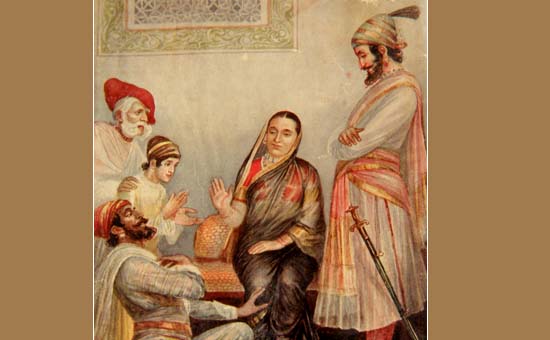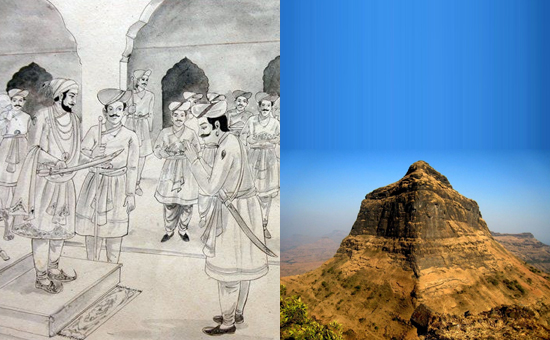- In a nutshell, this article tells you about Shivaji’s battles with the Mughals and the great Maratha victory in the Battle of Salher, one of the fiercest battles fought with Aurangzeb’s forces.
- Know how Shivaji Maharaj brought dismay and despair to Aurangzeb.
The Maratha kingdom was established by Shivaji raja and from 1656 the kingdom spread with a rapidity that alarmed the Mughals. In 1663, he attacked and chased away Shaista Khan, Aurangzeb’s uncle who had been staying in the Maratha ruler’s own house in Pune, by a lightning midnight raid. Then he attacked Surat in 1664. This led to a grand expedition against him led by Mirza raja Jaisingh that ended with the treaty of Purandar and a visit by Shivaji raja to Agra to meet Aurangzeb. Here, the reception accorded to him was not commensurate with what he had been promised and he expressed his annoyance in the court. What followed was a house arrest in Agra while Aurangzeb deliberated on how he could best use his illustrious prisoner.
However,
Shivaji raja and his elder son Sambhaji escaped from Agra and returned to the
fort of Rajgad, the capital, in late 1666. He then rapidly began to win back
forts that were lost.
Mughal Emperor Aurangzeb, disheartened by the escape of his enemy, sent his son Shah Alam with a 60-70000 strong cavalry to the Deccan. However, he advised him, "Shivaji
cannot be conquered by force. You go and stay at Aurangabad and win his
friendship by entering into negotiations for a treaty with him. If he does not
like to come to an interview, then excuse him that (formal) homage. And
granting Jagir in his name or in the name of his son get his army for service
with you. Work so, by giving him whatever rent free villages, money or military
outposts, he may demand, that Shivaji may become our servant."
Reaching Aurangabad, Shah Alam sent his
emissaries to Rajgad with a letter saying, ‘You and I should unite by treaty’.
The proposal was considered by the
Maratha raja. He then sent Raghunath pant Korde to Shah Alam who bestowed many
titles and jagirs to Shivaji raja. On his return with these to Rajgad, Shivaji
made a virtue of what was really a necessity.
He needed to rebuild his army and his kingdom and argued, “We have firstly, enmity with the Badshah of Bijapur,
enmity with the King of Bhaganagar, (and) enmity with the Mughals. Three such
enemies cannot be endured. Mine is a new kingdom, within it also my rule has
been established after enduring two or three very hard knocks. Therefore, one
enemy atleast should be made a friend, and for two years (I) should muster
strength and recover (my power). Then (I) should do what is fit.”
The
strategy in place, Shivaji turned his attention to the Bijapur kingdom and
conquered many of their forts. He amassed wealth needed to run a kingdom and
maintain an army. The Mughal districts in the Deccan also enjoyed peace.
Maratha Generals such as Pratap rao Gujar - who had been appointed in place of Netoji Palkar - and Niraji Pant were with Shah Alam. Aurangzeb, from Delhi, decided to break the amity between his son and the two Maratha representatives. Worried that this might lead to a rebellion against his own rule, he sent orders to imprison the two. However, Shah Alam’s leaked the information to the two, who quickly made their escape from Aurangabad and returned to Rajgad.
At Rajgad, Shivaji received the two and on hearing Aurangzeb’s perfidy, declared that war with the Mughals would commence. After repelling an attack by Bijapur on the fort Rangna, a major offensive was planned. There
were other important events that occurred in 1669. Aurangzeb ordered
that the temples of the Hindus would be demolished. The temple at Kashi was
demolished in August 1669 and in February 1670, even the Krishna temple at
Mathura was demolished.
The Maratha armies finally began their multi-pronged offensive with an invasion of the Baglan and Varhad province, taking fort after fort under Moropant Peshwa’s leadership. Aurangzeb sent a string of Mughal Generals with large armies against the Marathas.
 Tanaji’s vow to capture the fort of Sinhagad.
Tanaji’s vow to capture the fort of Sinhagad.
The
all-important fort of Salher near Nashik was captured at this time by the
Marathas, followed by Mulher. On 4 February 1670, Tanaji Malusare fell while
capturing the fort of Sinhagad from the Mughal killedar Udaibhan. A
month later, on 8 March 1670, Nilo Mujumdar captured the other strong fort of
Purandar. All the forts near Pune such
as Lohagad, Tung, Tikona and Visapur fell in rapid succession to the Maratha
onslaught.
It was then time for a second attack on the rich Mughal port of Surat. However, Shivaji raja was not one to delegate it to his Generals. He said, “(If)
the army (is led) by servants, the work is not likely to be done
satisfactorily. Therefore, if going (is decided) I should go in person with the
army.”
Starting with over twenty thousand men
with his chief officers, he began from the Konkan north of Kalyan and with a
rapidity that gave no warning, he fell upon Surat. This was not just a rich
Mughal port but also an embarkation place for the Haj. The earlier attack on
Surat in 1664 had led to a large army sent by Aurangzeb under Mirza raja
Jaisingh that led to a treaty under which Shivaji agreed to visit Agra.
Now, the loot
from Surat was designed to cripple the Mughal economy and land a blow on their prestige. A brief battle led to the defeat of the Mughal contingent and then the city was looted at leisure. The lengthy war and bondage inflicted by the Mughals on ‘my people’ will be fought using the money looted from them, said Shivaji.
From Surat, as the Marathas descended
to the Baglana, they were confronted by a Mughal General named Ikhlas Khan. The
Mughal army lost three to four thousand men. Many forts were captured. Mughal
cities as far away as in Varhad were looted. The Mughal Generals had to show
the Emperor that they were making strenuous efforts to oppose the Marathas. The
battle at Vani, near Nashik saw another victory for the Marathas. The defeated
Dilir Khan then went to Pune and massacred all residents of the city over nine
years of age.
There was consternation in Aurangzeb’s court at the series of defeats sustained by his Generals.
He would not send any of his sons lest they joined the Maratha king against him, and as the Sabhasad bakhar says of Aurangzeb’s strategy, “Should I myself gird my waist and march against Shivaji? Then what should I do if something like Shaista Khan's (affair) happens (to me)? Therefore, I shall not leave Delhi so long as Shivaji is alive.”
 Salher Fort
Salher Fort
So two of his foremost Generals Ikhlas
Khan and Bahlol Khan with twelve thousand horse were sent to take the lofty
fort of Salher. Dilel was sent against fort Ahivant. He was at the fort of
Kanera when Ramaji Pangera with just a thousand men attacked a Mughal force
several times larger. A fierce battle ensued. Twelve hundred pathans were
killed. It was the day of shimga. As the Mughal force surrounded this
small force, they threw off their upper garments and threw themselves on their
besiegers, all of them getting killed in the process. The courage of this small
Maratha contingent astonished the Mughal chief.
Then Ikhlas Khan and Bahlol Khan made
their move on the lofty fort of Salher. Shivaji raja prepared for this well. He
sent letters to Pratap rao Gujar from one
direction and asked Moropant Peshwa to come
from a different direction from the Konkan, trapping the Mughals between two
armies.
The Sabhasad bakhar gives the most authentic account of this stirring battle.
“From one side the cavalry charged on their horses, from another side the Mawles rushed in. And they fought. A great battle took place. For four prahars of the day the fighting lasted. Mughals, Pathans, Rajputs and Rohilas fought with artillery swivels carried on elephant and camel. As the fighting began, such a (cloud of) dust arose that for a space of three kos square, friend and foe could not be distinguished. Elephants were killed. Ten thousand men on the two sides became corpses. The horses, camels, elephants (killed) were beyond counting. A flood of blood streamed (in the battlefield). The blood formed a muddy pool and in it (people) began to sink, so (deep) was the mud. As the slaughter was carried on, not a living horse remained. The horses that were captured alive, numbered six thousand (when delivered) to the Raje. One hundred and twenty-five elephants were taken. Six thousand camels were captured. Goods, treasures, gold and jewels, clothes and carpets to sit on, beyond calculation came into (his) hands.”
From the Mughal army twenty-two of
their commanders including Ikhlas Khan and Bahlol Khan were captured. Only one
Maratha chief named Suryaji Kakde was killed. News of the victory reached Raja
Shivaji who richly rewarded his officers and men. At the same time, the
renowned Mughal chiefs were not dishonoured and sent away with gifts.
The battle of Salher was one of the few
pitched battles fought at the time and the triumph resonated in the land for a
long time afterwards.
In Delhi, the news of the
defeat plunged Aurangzeb into despair. For three days he did not emerge for the
pubic audience
“It seems,’ he said, ‘God has
taken away the Badshahi from the Musalmans and conferred it on Shivaji. It will
be well now if my death will occur now before that of Shivaji. Now the thought
of Shivaji does not agree with my life.”
There were many battles to come. For now, Shivaji raja crowned himself Chhatrapati in June 1674 in a grand ceremony at the fort of Raigad where he had shifted his capital a few years before this. Aurangzeb did not personally come to the Deccan as long
as Shivaji was alive. In fact in 1677, Shivaji could undertake a grand
expedition to conquer the south and took the extent of his kingdom to the banks
of the Cauvery. He reinforced the fort of Ginjee at this time and left it in
the hands of able lieutenants.
This ‘dakshin digvijay’ of the
Maratha king showed his great foresight, for when he died after a short illness
in 1680, Aurangzeb did descend into the Deccan to fight a prolonged
twenty-six-year war. He extinguished the kingdoms of Bijapur and Golkonda,
imprisoning those sultans, even captured and cruelly killed Chhatrapati
Sambhaji in 1689.
However, the embers for Maratha freedom lit by Chhatrapati Shivaji were too strong to be put out. Aurangzeb never saw his capital again and died defeated near Ahmednagar in 1707, his aim of subjugating the Marathas in tatters and his own Empire facing financial ruin.
From here on, the Marathas mastered the Mughals in the eighteenth century and under the Peshwas became the paramount power in India until 1803.
To read all
articles by author
Also read by author
1. To
see a video of trek and pictures of Salher Fort, at a height of 5,141 feet.
2. Chhatrapati Shivaji Maharaj – the King who cared for his people
3. Tanaji – The Hero of Sinhagad
4. Baji
Rao Peshwa the Great
5. How
the Marathas captured Atttock in modern day Pakistan
6. The Story of Thannjavur’s Maratha kings